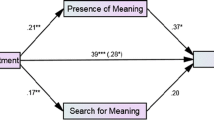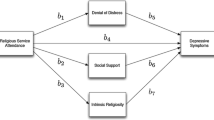Abstract
We examined the relationship between religious involvement and psychological distress and explored the mediating effects of social support and purpose in life in university students in western, mid-western, and eastern China. Cross-sectional survey of a representative sample of 1812 university students was conducted. The Purpose in Life scale, Duke Social Support Index, and Religious Commitment Inventory-10 were administered, along with Kessler’s Psychological Distress Scale. Structural equation modeling was used to test two models of the mediation hypothesis, examining direct, indirect, and total effects. Model 1 (with direction of effect hypothesized from religiosity to psychological distress) indicated that religious involvement had a direct effect on increasing psychological distress (β = 0.23, p < .01) with minor mediated effects. However, Model 2 (with direction of effect hypothesized from psychological distress to religiosity) indicated strong indirect protective effects of religiosity on psychological distress through purpose in life and social support (β = −.40, p < .01). The findings are consistent with the hypothesis that psychological distress increases religious involvement, which then increases purpose in life and social support that then lead to lower psychological distress.

Similar content being viewed by others
References
Andrews, G., & Slade, T. (2001). Interpreting scores on the Kessler Psychological Distress Scale (K10). Australian and New Zealand Journal of Public Health, 25(6), 494–497. doi:10.1111/j.1467-842X.2001.tb00310.x.
Balbuena, L., Baetz, M., & Bowen, R. (2013). Religious attendance, spirituality, and major depression in Canada: A 14-year follow-up study. Canadian Journal of Psychiatry, 58(4), 225–232.
Bonelli, R. M., & Koenig, H. G. (2013). Mental disorders, religion and spirituality 1990 to 2010: A systematic evidence-based review. Journal of Religion and Health, 52(2), 657–673. doi:10.1007/s10943-013-9691-4.
Butcher, J. N., Dahlstrom, W. G., Graham, J. R., Tellegen, A., & Kaemmer, B. (1989). The Minnesota multiphasic personality inventory-2 (MMPI-2) manual for administration and scoring. Minneapolis, MN: University of Minneapolis Press.
Chen, Y., Wang, J., Weng, H., & Wang, X. (2012). History, present situation, and problems of Chinese psychology of religion. Pastoral Psychology, 61(5), 641–654. doi:10.1007/s11089-011-0399-7.
Chiang, H. (2014). Psychiatry and Chinese history. London: Pickering & Chatto Ltd.
Dein, S., Cook, C. C., & Koenig, H. G. (2012). Religion, spirituality, and mental health: Current controversies and future directions. The Journal of Nervous and Mental Disease, 200(10), 852–855. doi:10.1097/NMD.0b013e31826b6dle.
Durden, E. D., Hill, T. D., & Angel, R. J. (2007). Social demands, social supports, and psychological distress among low-income women. Journal of Social and Personal Relationships, 24(3), 343–361. doi:10.1177/0265407507077226.
Feng, X., Yang, X., Yang, Z., Peng, F., Zhang, X., & Koenig, H. G. (2016). Religion and psychological well-being in Chinese college students: Does meaningfulness matter? Journal of Religion and Health (in submission).
Greenberg, D. (2013). Religion and mental health: A double-edged sword or a life-giving medicine? World Psychiatry, 12(1), 40–41. doi:10.1002/wps.20012.
Holroyd, E. (2002). Health-seeking behaviors and social change: The experience of the Hong Kong Chinese elderly. Qualitative Health Research, 12(6), 731–750.
Hu, L. T., & Bentler, P. M. (1999). Cutoff criteria for fit indexes in covariance structure analysis: Conventional criteria versus new alternatives. Structural Equation Modeling-A Multidisciplinary Journal, 6(1), 1–55. doi:10.1080/10705519909540118.
Huang, B., Appel, H. B., Ai, A. L., & Lin, C. J. (2012). Religious involvement effects on mental health in Chinese Americans. Asian Culture and History, 4(1), 2.
Ivtzan, I., Chan, C. P., Gardner, H. E., & Prashar, K. (2013). Linking religion and spirituality with psychological well-being: Examining self-actualisation, meaning in life, and personal growth initiative. Journal of Religion and Health, 52(3), 915–929. doi:10.1007/s10943-011-9540-2.
Kessler, R. C., Andrews, G., Colpe, L. J., Hiripi, E., Mroczek, D. K., Normand, S. L., et al. (2002). Short screening scales to monitor population prevalences and trends in non-specific psychological distress. Psychological Medicine, 32(6), 959–976. doi:10.1017/S0033291702006074.
Kidwai, R., Mancha, B. E., Brown, Q. L., & Eaton, W. W. (2014). The effect of spirituality and religious attendance on the relationship between psychological distress and negative life events. Social Psychiatry and Psychiatric Epidemiology, 49(3), 487–497. doi:10.1007/s00127-013-0723-x.
Koenig, H. G. (2012). Religion and mental health. In K. D. Koenig, G. Harold, & B. Carson Verna (Eds.), Handbook of religion and health (2nd ed.). New York: Oxford University Press.
Koenig, H. G., Hays, J. C., George, L. K., Blazer, D. G., Larson, D. B., & Landerman, L. R. (1997). Modeling the cross-sectional relationships between religion, physical health, social support, and depressive symptoms. The American Journal of Geriatric Psychiatry, 5(2), 131–144.
Koenig, H. G., Westlund, R. E., George, L. K., Hughes, D. C., Blazer, D. G., & Hybels, C. (1993). Abbreviating the Duke Social Support Index for use in chronically ill elderly individuals. Psychosomatics, 34, 61–69.
Kovess-Masfety, V., Dezetter, A., de Graaf, R., Haro, J. M., Bruffaerts, R., Briffault, X., et al. (2010). Religious advisors’ role in mental health care in the European Study of the Epidemiology of Mental Disorders survey. Social Psychiatry and Psychiatric Epidemiology, 45(10), 989–998. doi:10.1007/s00127-009-0143-0.
Krause, N., Ingersoll-Dayton, B., Liang, J., & Sugisawa, H. (1999). Religion, social support, and health among the Japanese elderly. Journal of Health and Social Behavior, 40(4), 405–421.
Law, B. M. (2012). Psychometric properties of the existence subscale of the purpose in life questionnaire for Chinese adolescents in Hong Kong. The Scientific World Journal. doi:10.1100/2012/685741
Liang, L. (2012). Multiple variations: Perspectives on the Religious Psychology of Buddhist and Christian Converts in the People’s Republic of China. Pastoral Psychology, 61(5), 865–877. doi:10.1007/s11089-012-0462-z.
Linden, S. C., Harris, M., Whitaker, C., & Healy, D. (2010). Religion and psychosis: The effects of the Welsh religious revival in 1904-1905. Psychological Medicine, 40(8), 1317–1323. doi:10.1017/S0033291709991917.
Luo, Y. (2004). On modern social value of psychological regulation: Function of religion. Journal of South-Central University for Nationalities (Humanities and Social Sciences), 24(5), 53–55.
Miller, L., Bansal, R., Wickramaratne, P., Hao, X., Tenke, C. E., Weissman, M. M., & Peterson, B. S. (2014). Neuroanatomical correlates of religiosity and spirituality: A study in adults at high and low familial risk for depression. JAMA Psychiatry, 71(2), 128–135. doi:10.1001/jamapsychiatry.2013.3067.
Miller, L., Wickramaratne, P., Gameroff, M. J., Sage, M., Tenke, C. E., & Weissman, M. M. (2012). Religiosity and major depression in adults at high risk: A ten-year prospective study. The American Journal of Psychiatry, 169(1), 89–94. doi:10.1176/appi.ajp.2011.10121823.
O’Connor, D. B., Cobb, J., & O’Connor, R. C. (2003). Religiosity, stress and psychological distress: No evidence for an association among undergraduate students. Personality and Individual Differences, 34(2), 211–217.
Pew Research Center. (2012). More than 600 million in China are religiously affiliated as Chinese New Year 2013 dawns. Pew Forum on Religion & Public Life. Retrieved April 12, 2014, from http://www.theweeklynumber.com/1/post/2013/02/more-than-600-million-in-china-are-religiously-affiliated-as-chinese-new-year-2013-dawns.html.
Phillips, M. R. (1998). The transformation of China’s Mental Health Services. The China Journal 39, 1–36. doi:10.2307/2667691
Phillips, M. R., Zhang, J., Shi, Q., Song, Z., Ding, Z., Pang, S., & Wang, Z. (2009). Prevalence, treatment, and associated disability of mental disorders in four provinces in China during 2001–05: An epidemiological survey. Lancet, 373(9680), 2041–2053. doi:10.1016/S0140-6736(09)60660-7.
Sampford, M. R. (1962). Methods of cluster sampling with and without replacement for clusters of unequal sizes. Biometrika, 49(1/2), 27–40. doi:10.1093/biomet/49.1-2.27.
Schulenberg, S. E., Schnetzer, L. W., & Buchanan, E. M. (2011). The purpose in life test-short form: Development and psychometric support. Journal of Happiness Studies, 12(5), 861–876.
Shek, D. T. (1992). Meaning in life and psychological well-being: An empirical study using the Chinese version of the Purpose in Life questionnaire. The Journal of genetic psychology, 153(2), 185.
Shoesmith, E. (2002). Structural equation modeling with AMOS: Basic concepts, applications, and programming (Vol. 51, pp. 408–409). St. Luke: Royal Statistical Society.
Simpson, J. A. (2002). The ultimate Elixir? Psychological Inquiry, 13(3), 226–229. doi:10.2307/1449338.
Smith, C. (2003). Theorizing religious effects among American adolescents. Journal for the Scientific Study of Religion, 42(1), 17–30. doi:10.1111/1468-5906.t01-1-00158.
Stark, R., & Liu, E. Y. (2011). The religious awakening in China. Review of Religious Research, 52, 282–289.
Steger, M. F., & Frazier, P. (2005). Meaning in life: One link in the chain from religiousness to well-being. Journal of Counseling Psychology, 52(4), 574–582. doi:10.1037/0022-0167.52.4.574.
Tabak, M. A., & Mickelson, K. D. (2009). Religious service attendance and distress: The moderating role of stressful life events and race/ethnicity. Sociology of Religion, 70(1), 49–64. doi:10.1093/socrel/srp001.
Tierney, B., & Brown, P. H. (2009). Religion and subjective well-being among the elderly in China. The Journal of Socio-Economics, 38(2), 310–319. doi:10.1016/j.socec.2008.07.014.
Vail, K. E., Arndt, J., & Abdollahi, A. (2012). Exploring the existential function of religion and supernatural agent beliefs among Christians, Muslims, atheists, and agnostics. Personality and Social Psychology Bulletin, 38(10), 1288–1300. doi:10.1177/0146167212449361.
Wei, D., & Liu, E. Y. (2013). Religious involvement and depression: evidence for curvilinear and stress-moderating effects among young women in rural China. Journal for the Scientific Study of Religion, 52(2), 349–367. doi:10.1111/jssr.12031.
Worthington, E. L, Jr, Wade, N. G., Hight, T. L., Ripley, J. S., McCullough, M. E., Berry, J. W., et al. (2003). The Religious Commitment Inventory–10: Development, refinement, and validation of a brief scale for research and counseling. Journal of Counseling Psychology, 50(1), 84–96. doi:10.1037/0022-0167.50.1.84.
Yao, X. (2006). Religious experience in contemporary China. Modern Believing, 47(2), 44–61. doi:10.3828/MB.47.2.44.
Yao, X. (2007). Religious belief and practice in Urban China 1995–2005. Journal of Contemporary Religion, 22(2), 169–185. doi:10.1080/13537900701331031.
Yeung, A. S., & Kam, R. (2005). Illness beliefs of depressed Asian Americans in primary care. In A. M. Georgiopoulos & J. F. Rosenbaum (Eds.), Perspectives in cross-cultural psychiatry (pp. 21–36). New York: Lippincott Williams & Wilkins.
Zhang, J., & Jia, C. (2012). Psychometric characteristics of the Duke Social Support Index in a young rural Chinese population. Death Studies, 36(9), 858–869. doi:10.1080/07481187.2011.604462.
Acknowledgments
This study was partly supported by the National Natural Science Funds of China (81060242) and National Undergraduate Scientific and Technological Innovation Project (2013-11). The funders did not involve in study design, data analysis, decision to publish, or preparation of this manuscript.
Author information
Authors and Affiliations
Corresponding author
Ethics declarations
Conflict of interest
The authors declare that they have no conflict of interest.
Rights and permissions
About this article
Cite this article
Wang, Z., Koenig, H.G., Ma, H. et al. Religion, Purpose in Life, Social Support, and Psychological Distress in Chinese University Students. J Relig Health 55, 1055–1064 (2016). https://doi.org/10.1007/s10943-016-0184-0
Published:
Issue Date:
DOI: https://doi.org/10.1007/s10943-016-0184-0




